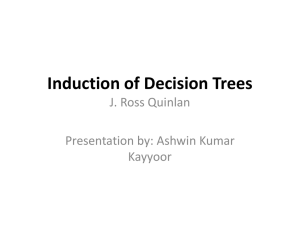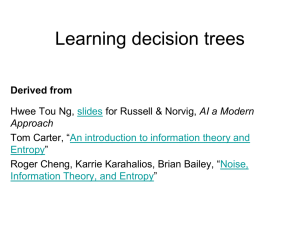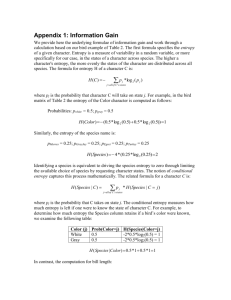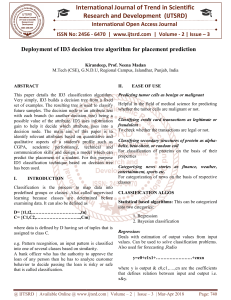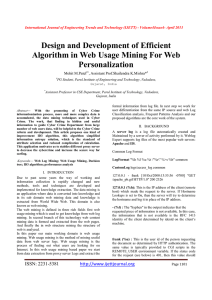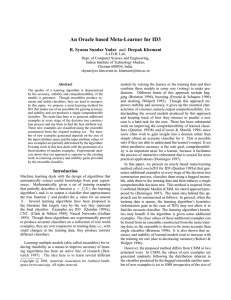ID3 Algorithm - Department of Computer Science
advertisement
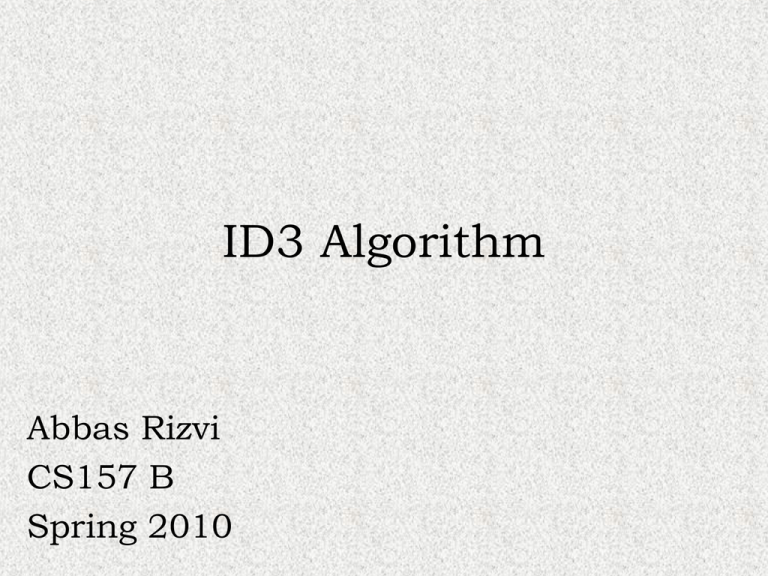
ID3 Algorithm
Abbas Rizvi
CS157 B
Spring 2010
What is the ID3 algorithm?
• ID3 stands for Iterative
Dichotomiser 3
• Algorithm used to generate a decision
tree.
• ID3 is a precursor to the C4.5
Algorithm.
History
• The ID3 algorithm was invented by
Ross Quinlan.
• Quinlan was a computer science
researcher in data mining, and
decision theory.
• Received doctorate in computer
science at the University of
Washington in 1968.
Decision Tree
• Classifies data using the attributes
• Tree consists of decision nodes and
decision leafs.
• Nodes can have two or more branches
which represents the value for the
attribute tested.
• Leafs nodes produces a homogeneous
result.
The algorithm
• The ID3 follows the Occam’s razor
principle.
• Attempts to create the smallest
possible decision tree.
The Process
• Take all unused attributes and
calculates their entropies.
• Chooses attribute that has the lowest
entropy is minimum or when
information gain is maximum
• Makes a node containing that
attribute
The Algorithm
• Create a root node for the tree
• If all examples are positive, Return the
single-node tree Root, with label = +.
• If all examples are negative, Return the
single-node tree Root, with label = -.
• If number of predicting attributes is empty,
then Return the single node tree Root, with
label = most common value of the target
attribute in the examples.
The Algorithm (cont.)
• Else
– A = The Attribute that best classifies examples.
– Decision Tree attribute for Root = A.
– For each possible value, vi, of A,
• Add a new tree branch below Root, corresponding to the test
A = vi.
• Let Examples(vi), be the subset of examples that have the
value vi for A
• If Examples(vi) is empty
– Then below this new branch add a leaf node with label = most
common target value in the examples
• Else below this new branch add the subtree ID3
(Examples(vi), Target_Attribute, Attributes – {A})
• End
• Return Root
Entropy
• Formula to calculate
• A complete homogeneous sample has an
entropy of 0
• An equally divided sample as an entropy of
1
• Entropy = - p+log2 (p+) -p-log2 (p-) for a
sample of negative and positive elements.
Exercise
•
•
•
•
•
Calculate the entropy
Given:
Set S contains14 examples
9 Positive values
5 Negative values
Exercise
• Entropy(S) = - (9/14) Log2 (9/14) (5/14) Log2 (5/14)
• = 0.940
Information Gain
• Information gain is based on the
decrease in entropy after a dataset is
split on an attribute.
• Looking for which attribute creates
the most homogeneous branches
Information Gain Example
• 14 examples, 9 positive 5 negative
• The attribute is Wind.
• Values of wind are Weak and Strong
Exercise (cont.)
• 8 occurrences of weak winds
• 6 occurrences of strong winds
• For the weak winds, 6 are positive and
2 are negative
• For the strong winds, 3 are positive
and 3 are negative
Exercise (cont.)
• Gain(S,Wind) =
• Entropy(S) - (8/14)*Entropy (Weak)
-(6/14)*Entropy (Strong)
• Entropy(Weak) = - (6/8)*log2(6/8) (2/8)*log2(2/8) = 0.811
• Entropy(Strong) = - (3/6)*log2(3/6) (3/6)*log2(3/6) = 1.00
Exercise (cont.)
• So…
• 0.940 - (8/14)*0.811 - (6/14)*1.00
• = 0.048
Advantage of ID3
• Understandable prediction rules are
created from the training data.
• Builds the fastest tree.
• Builds a short tree.
• Only need to test enough attributes
until all data is classified.
• Finding leaf nodes enables test data to
be pruned, reducing number of tests.
Disadvantage of ID3
• Data may be over-fitted or overclassified, if a small sample is tested.
• Only one attribute at a time is tested
for making a decision.
• Classifying continuous data may be
computationally expensive, as many
trees must be generated to see where
to break the continuum.
Questions




